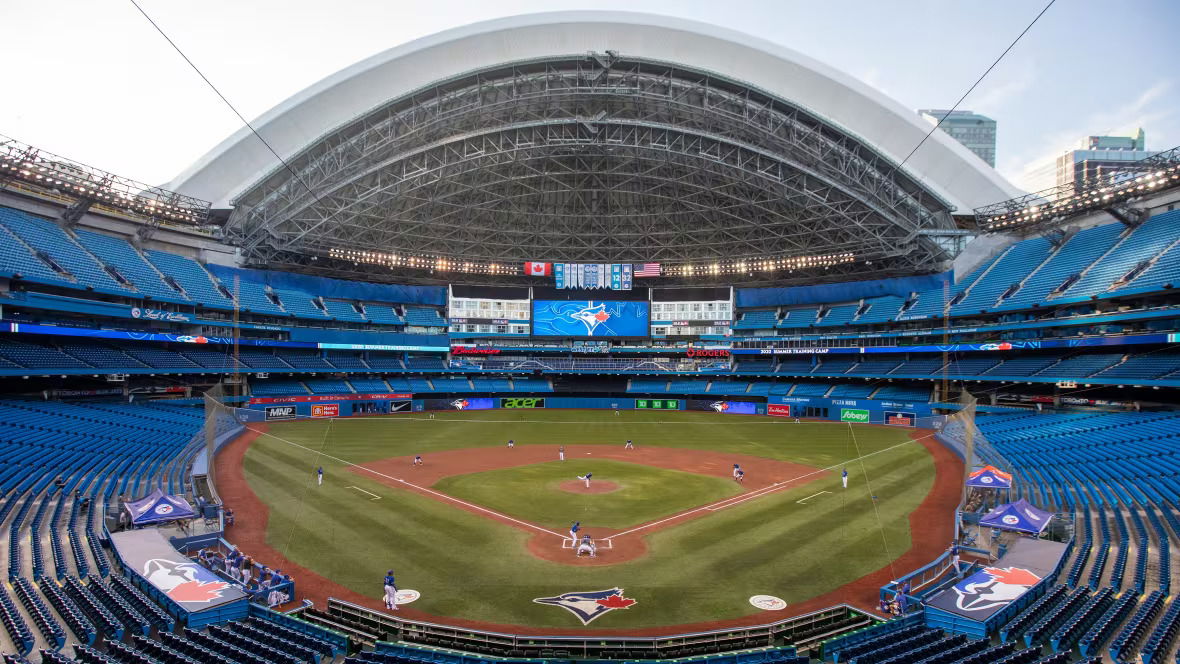
Imago
Source: Carlos Osorio/The Canadian Press

Imago
Source: Carlos Osorio/The Canadian Press
Wow, Game 6 of the World Series between the Los Angeles Dodgers and the Toronto Blue Jays was one of the best games in MLB history. It had everything from errors to missed calls to lodged balls. And guess what, the World Series is going to Game 7. After a cinematic end to Game 6, the World Series is heading to a Game 7, but what was the cinematic end about?
Watch What’s Trending Now!
Game 6 of the World Series had everything baseball could offer, from errors to replay reviews and heartbreak. The Los Angeles Dodgers kept their title defense alive with a 3–1 win over Toronto. The Blue Jays loaded the bases late, but a sharp liner turned double play ended their rally.
One of the game’s most talked-about moments came when Addison Barger’s hit lodged into the left-center wall. The outfield umpire immediately signaled a ground-rule double, applying Rule 5.05(a)(7) as written in the MLB rulebook. That ruling awarded two bases to the runners, leaving fans momentarily confused before the replay confirmed the decision.
ADVERTISEMENT
Rule 5.05(a)(7) states that a ball is considered lodged when its natural flight is stopped unnaturally. The fielder’s ability to retrieve the ball doesn’t matter; the call depends solely on the umpire’s judgment. Once a rule is lodged, play is halted, and each runner, including the batter, receives two bases from the pitch.
The fact this is ruled a “lodged ball” but then the CF has no problem picking it up and throwing it in is dumb.
He didn’t even make an effort to grab it right away.
Blue Jays might have gotten screwed
— J.D. Andress (@Jdandress11) November 1, 2025
If the umpire cannot clearly see the lodged ball, play continues until inspection or replay determines otherwise. The rule ensures consistency, preventing either team from gaining an unfair advantage due to unpredictable bounces. For Toronto, that moment symbolized the night, precision by the book, yet heartbreak by the inning.
ADVERTISEMENT
Game 6 proved that even chaos has a rulebook, and the Blue Jays learned it the hard way. The lodged ball became baseball’s most unwanted tutorial, perfectly timed under postseason lights, showing how even the strangest moments are governed by structure. Baseball’s rulebook exists for exactly these situations.
The following three rules—5.06(b)(4)(F), 5.05(a)(8), and 8.01(c)—highlight how MLB maintains fairness in rare or unusual plays that can quickly shift the momentum of a game.
ADVERTISEMENT
- Rule 5.06(b)(4)(F)
This rule explains how bases are awarded when a fair ball becomes lodged in a fence or other obstruction. In such cases, runners are typically awarded two bases—from the time of the pitch if the ball goes out of play naturally, or from the time of the throw if it’s deflected out by a fielder. It ensures consistent treatment of unpredictable plays that take the ball out of standard action.
- Rule 5.05(a)(8)
Building on the same principle of fairness, this rule applies when a fielder deflects a fair bounding ball into the stands or over a fence. Both the batter and all runners are awarded two bases, and the ball is declared dead immediately, stopping play so runners can advance safely from their positions at the time of the deflection.
- Rule 8.01(c)
This rule focuses on a pitcher’s legal movement when making a throw to a base. The pitcher must step directly toward that base before throwing; otherwise, it is considered a balk. The rule helps maintain fairness and transparency between pitchers and base runners, preserving the integrity of in-play movements.
Now, with Scherzer waiting and Roberts watching, Game 7 promises either redemption or repeat glory.
ADVERTISEMENT
John Schneider reacts to the cinematic end to MLB World Series Game 6
Baseball loves its drama, but this one felt scripted by the universe itself. In a sport obsessed with inches and instincts, fate decided to take the wheel and park the ball, literally. The MLB World Series Game 6 between the Toronto Blue Jays and Los Angeles Dodgers didn’t just flirt with chaos; it married it. And when the dust settled, John Schneider had plenty to shake his head at.
The Toronto Blue Jays trailed 3-1 in the bottom of the ninth in Game 6. Addison Barger sent a 98 mph fastball deep to left-center, where it hit the wall and lodged. Myles Straw and Barger sprinted home, but the play was ruled dead, ending Toronto’s comeback hopes and sealing a 3-1 Los Angeles Dodgers win.
Top Stories
“We’re the Pittsburgh Pirates”- Mets Radio Host Criticizes Steve Cohen for Duping Queens Fans After Dismantling the Core

Phillies Warned Of ‘Quiet Coup’ on Kyle Schwarber After Philadelphia Star Confirms Exit Plans

Cal Raleigh Sets MLB Rivalries Aside for $29M Cubs Star as He Drops Major WBC Decision for America

Shohei Ohtani Fear Fades as 36-Year-Old Teammate Terrifies MLB Managers Amid Rising Dodgers Dominance

ESPN Insider Loses Faith in David Stearns After Pete Alonso- Jorge Polanco “Headscratcher” Leaves Juan Soto & Mets Vulnerable

Manager John Schneider called it “a tough break,” adding he had “never seen a ball get lodged ever.” Barger said, “I saw it hit the wall, I didn’t really see after that,” showing his disbelief. Straw echoed the confusion, admitting “no one has ever really seen the ball do that here.” As fans stood stunned, Toronto’s chance to tie the World Series slipped away into the outfield wall.
ADVERTISEMENT
Baseball often promises heartbreak, but the Blue Jays found a brand-new way to feel it. The Dodgers didn’t just defend a lead; they benefited from physics’ cruelest inside joke. If fate had a glove, it was clearly wearing Dodger blue in Game 6.
ADVERTISEMENT
ADVERTISEMENT
ADVERTISEMENT

